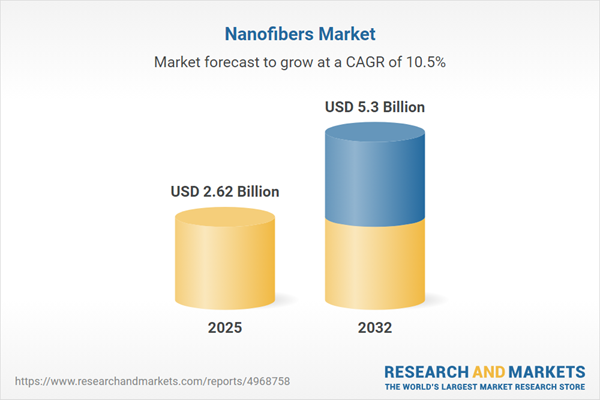Speak directly to the analyst to clarify any post sales queries you may have.
Nanofibers have rapidly become integral to advanced materials, driving innovation across industries through their unique structural and functional properties. Senior decision-makers are increasingly evaluating nanofiber technologies as key enablers for leaner, higher-performance solutions in core sectors.
Market Snapshot: Nanofibers Market Growth Trajectory
The nanofibers market grew from USD 2.38 billion in 2024 to USD 2.62 billion in 2025, and is projected to reach USD 5.30 billion by 2032, exhibiting a robust CAGR of 10.52%. Demand is fueled by the expansion of application areas, production improvements, and a changing regulatory landscape rewarding sustainability and performance. The market demonstrates rising adoption in high-value fields from healthcare to energy storage, supported by global advances in manufacturing capacity and research partnerships.
Scope & Segmentation: Extensive Insights Across Product Types, Technologies, and Regions
- Product Types: Carbon nanofiber, ceramic nanofiber, composite nanofiber, metallic nanofiber, polymeric nanofiber
- Fabrication Technologies: Electrospinning, melt blowing, phase separation, self-assembly, template synthesis
- End-Use Industries: Aerospace and defense, automotive, chemical, electronics, energy (including battery electrodes and supercapacitors), healthcare and pharmaceutical (including medical devices)
- Regional Markets: Americas (United States, Canada, Mexico, Brazil, Argentina, Chile, Colombia, Peru), Europe, Middle East & Africa (United Kingdom, Germany, France, Russia, Italy, Spain, Netherlands, Sweden, Poland, Switzerland, United Arab Emirates, Saudi Arabia, Qatar, Turkey, Israel, South Africa, Nigeria, Egypt, Kenya), Asia-Pacific (China, India, Japan, Australia, South Korea, Indonesia, Thailand, Malaysia, Singapore, Taiwan)
- Key Companies Analyzed: Ahlstrom-Munksjö, Argonide Corporation, Asahi Kasei Corporation, Chemazone Inc, Donaldson Company Inc., DuPont de Nemours Inc., Elmarco s.r.o., eSpin Technologies Inc., Hollingsworth & Vose, Inovenso Technology, Johns Manville, Mann+Hummel, Materic Group, MemPro USA Ltd., Merck KGaA, Nippon Paper Industries Co. Ltd, NXTNANO, SPUR a.s., Teijin Limited, Toray Industries Inc., US Global Nanospace Inc.
Key Takeaways for Decision-Makers
- Nanofibers serve as foundational elements in next-generation materials, enabling more efficient filtration, sensing, and lightweight composites across critical applications.
- Refined control over fiber diameter and pore structure is unlocking opportunities in water purification, electronics, and energy storage, accommodating rigorous industry standards and regulatory expectations.
- Technological advances—such as evolving electrospinning and hybrid processing—are expanding both production scale and application diversity, meeting the needs of rapidly shifting end markets.
- Sustainability is increasingly prioritized, with companies investing in bio-based polymers, solvent recovery, and circular manufacturing to align with environmental requirements in Europe and beyond.
- The Americas leverage strong research ecosystems and manufacturing clusters, while Asia-Pacific’s cost structures and government policies drive large-scale manufacturing and global distribution.
- Strategic supplier partnerships and IP-driven differentiation are shaping competitive advantages and reducing barriers to adoption in key verticals.
2025 United States Tariffs: Navigating Cost and Supply Chain Strategies
New tariffs on nanofiber-related imports in the United States are resulting in increased landed costs of materials and finished membranes. This shift is prompting manufacturers to reassess procurement strategies, diversify suppliers outside tariff zones, and explore domestic production incentives. Implementation of logistics optimization and advanced inventory management is helping to minimize disruption. Organizations adapting agile sourcing and risk mitigation measures are better positioned to maintain supply continuity and pricing stability despite evolving trade policies.
Methodology & Data Sources
This report is grounded in a multi-layered research process that incorporates secondary data reviews from patent and scientific literature, expert interviews, and structured surveys across the supply chain. Quantitative metrics were validated using advanced analytics and triangulated with primary feedback from polymer suppliers, fiber producers, and end users to ensure accuracy and reliability.
Why This Report Matters: Strategic Value for Business Leaders
- Enables executive teams to benchmark emerging material science advances against competitive industry standards
- Offers focused insights on risk mitigation, supplier diversification, and technology investments in response to shifting tariffs and regulatory drivers
- Empowers informed decision-making for R&D, market entry, and strategic partnerships across regional and vertical markets
Conclusion
The nanofibers market is evolving in response to rapid technological innovations and growing sustainability demands. Forward-thinking organizations leveraging advanced fabrication methods and resilient sourcing strategies will be well-positioned to capitalize on new opportunities and drive value in this dynamic sector.
Additional Product Information:
- Purchase of this report includes 1 year online access with quarterly updates.
- This report can be updated on request. Please contact our Customer Experience team using the Ask a Question widget on our website.
Table of Contents
3. Executive Summary
4. Market Overview
7. Cumulative Impact of Artificial Intelligence 2025
Companies Mentioned
The companies profiled in this Nanofibers market report include:- Ahlstrom-Munksjö
- Argonide Corporation
- Asahi Kasei Corporation
- Chemazone Inc
- Donaldson Company, Inc.
- DuPont de Nemours, Inc.
- Elmarco s.r.o.
- eSpin Technologies Inc.
- Hollingsworth & Vose
- Inovenso Technology
- Johns Manville
- Mann+Hummel
- Materic Group
- MemPro USA Ltd.
- Merck KGaA
- Nippon Paper Industries Co. Ltd
- NXTNANO
- SPUR a.s.
- Teijin Limited
- Toray Industries, Inc.
- US Global Nanospace, Inc.
Table Information
| Report Attribute | Details |
|---|---|
| No. of Pages | 190 |
| Published | November 2025 |
| Forecast Period | 2025 - 2032 |
| Estimated Market Value ( USD | $ 2.62 Billion |
| Forecasted Market Value ( USD | $ 5.3 Billion |
| Compound Annual Growth Rate | 10.5% |
| Regions Covered | Global |
| No. of Companies Mentioned | 22 |









